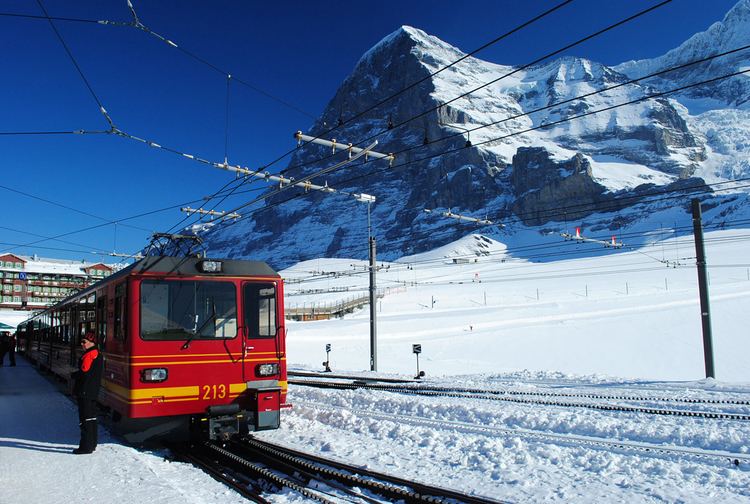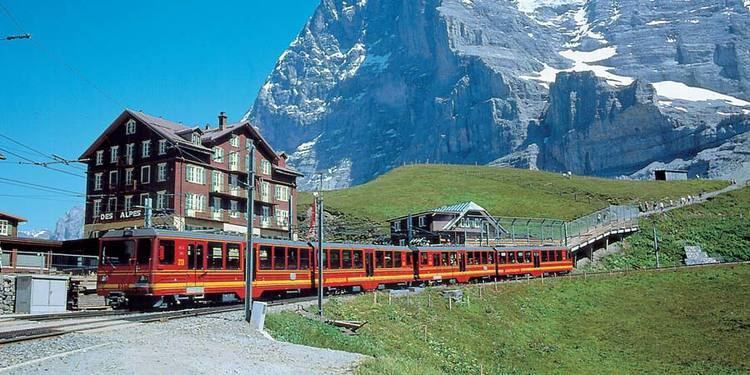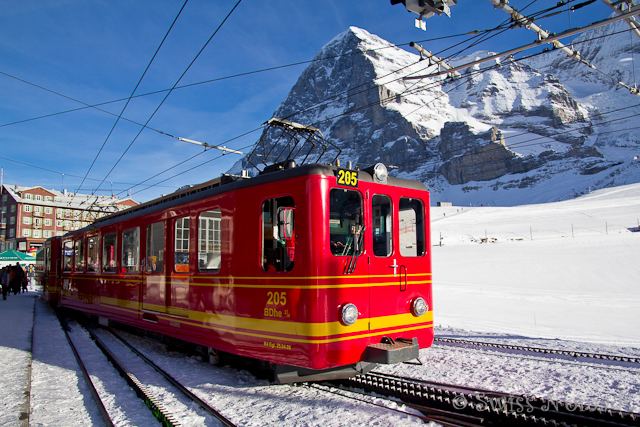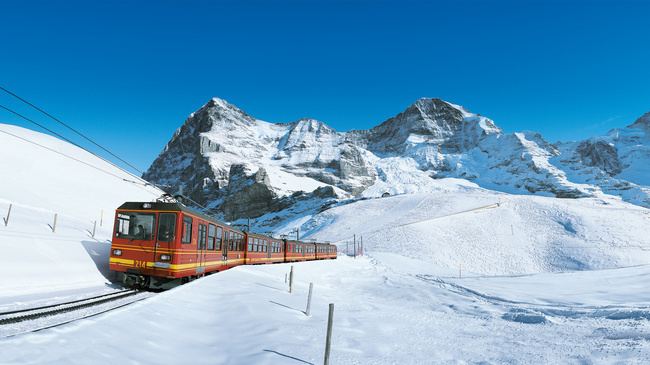Line length 9.3 km (5.8 mi) Minimum radius 100 m | Track gauge 1 Metre (3 ft 3 ⁄8 in) Highest elevation 3,454 m (11,332 ft) | |
 | ||
Locale Bern/Valais, Switzerland Electrification 3-phase, 1,125 V, 50 Hz | ||
The Jungfrau railway (German: Jungfraubahn, JB) is a metre gauge (3 ft 3 3⁄8 in gauge) rack railway which runs 9 kilometres (5.6 mi) from Kleine Scheidegg to the highest railway station in Europe at Jungfraujoch (3,454 m), between the Bernese Oberland and Valais in Switzerland. The railway runs almost entirely within the Jungfrau Tunnel, built into the Eiger and Mönch mountains and containing two stations in the middle of the tunnel, where passengers can disembark to observe the neighbouring mountains through windows built into the mountainside. The initial open-air section culminates at Eigergletscher (2,320 m), which makes it the second highest open-air railway in Switzerland. The line is electrified at 3-phase 1,125 volts 50 Hertz, and is one of four lines in the world using three-phase electric power.
Contents

At Kleine Scheidegg the JB connects with the Wengernalpbahn (WAB), which has two routes down the mountain, running respectively to the villages of Lauterbrunnen and Grindelwald. From both villages, branches of the Berner Oberland Bahn (BOB) connect to the Swiss Federal Railways at Interlaken.

The line is owned by the Jungfraubahn Holding AG, a holding company that also owns the Wengernalpbahn and Lauterbrunnen–Mürren mountain railway railways. Through that holding company it is part of the Allianz - Jungfrau Top of Europe marketing alliance, which also includes the separately owned Berner Oberland Bahn and Schynige Platte railways.

History

Stations
2008 proposals

In early 2008, Jungfraubahn Holding AG announced it is exploring the futuristic idea of an efficient fast form of access to the Jungfraujoch as an addition to the rack railway. A feasibility study has been commissioned. The additional access would be the world's longest tunnel-lift system. The study is to show if and how such a tunnel-lift system - for example as a fast lift or funicular - from the Lauterbrunnen Valley to the Jungfraujoch could be realised without disturbing the unique landscape of the UNESCO World Heritage site.
The attractiveness of the cogwheel railway should thus be enhanced, as guests could use the fast lift for the uphill or downhill journey. Through a marked reduction in travelling time, the trip to the Jungfraujoch could also become a half-day excursion.
These plans have later been abandoned and the company is currently (2017) planning to build an aerial cableway betweeen Grindelwald Grund and Eigergletscher.
Rolling stock
Since most of the railway is inside a tunnel, it was designed to run with electricity from conception. The latest rolling stock consists of twin-unit motorcoaches carrying up to 230 people per train which operate at 12.5 km/h on the steepest parts of the ascent. The motors function at two speeds which allows the units to operate at double this speed on the less steep part of the ascent (above Eismeer station).
The motors will operate in a regenerative mode which allows the trains to generate electricity during the descent, which is fed back into the power distribution system. Approximately 50% of the energy required for an ascent is recovered during the descent. It is this generation that regulates the descent speed.
Motive power delivered since 1992 (numbers 211...224) no longer has directly fed three phase motors but is equipped similarly to a normal single phase locomotive. This rolling stock can travel at variable speed which allowed to cut journey time from 52 to 35 min with the timetable starting 11 December 2016. Pre-1992 rolling stock can no longer be used in regular traffic and most of the earlier trains have been scrapped.
Snow clearing equipment is essential on the open section of line between Kleine Scheidegg railway station and Eigergletscher railway station. Originally snow ploughs were used but more recently snow blowing equipment has been brought into service.
The railway also operates some dedicated freight vehicles to supply the visitor facilities at Jungfraujoch, including a tank to transport additional water.
